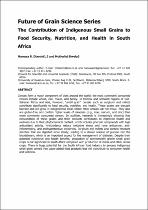 ResearchSpace
ResearchSpace
The future of grain science: the contribution of indigenous small grains to food security, nutrition and health in South Africa [AACCI Report]
JavaScript is disabled for your browser. Some features of this site may not work without it.
- ResearchSpace
- →
- Research Publications/Outputs
- →
- Journal Articles
- →
- View Item
| dc.contributor.author |
Dlamini, Nomusa R

|
|
| dc.contributor.author |
Siwela, M

|
|
| dc.date.accessioned | 2015-10-07T06:17:38Z | |
| dc.date.available | 2015-10-07T06:17:38Z | |
| dc.date.issued | 2015-08 | |
| dc.identifier.citation | Dlamini, N., and Siwela, M., 2015. The future of grain science: the contribution of indigenous small grains to food security, nutrition and health in South Africa [AACCI Report]. Journal of Cereal Foods World, Vol. 60(4), pp. 4pp | en_US |
| dc.identifier.issn | 0146-6283 | |
| dc.identifier.uri | http://hdl.handle.net/10204/8158 | |
| dc.description | Copyright: 2015. AACC International. Due to copyright restrictions, the attached PDF file only contains the abstract of the full text item. For access to the full text item, please consult the publisher's website. The definitive version of the work is published in the Journal of Cereal Foods World, Vol. 60(4), pp. 4pp | en_US |
| dc.description.abstract | Cereals form a major component of diets around the world; the most commonly consumed cereals include wheat, rice, maize, and barley. In tropical and semiarid regions of Sub-Saharan Africa and Asia, however, 'small grain' cereals such as sorghum and millets contribute significantly to food security, nutrition, and health. These grains are drought tolerant and will grow in marginalized areas where other cereals will not thrive. They also are gluten-free and contain higher levels of minerals (e.g., iron, calcium, and zinc) than more commonly consumed cereals. In addition, research is increasingly showing that consumption of these grains and their products contributes to improved health and wellness due to their phytochemical content, which includes phenolic compounds with high antioxidant activity. Antioxidants reduce oxidative stress and have anticancer, anti-inflammatory, and antihypertensive properties. Sorghum and millets also contain resistant starches that are digested more slowly, leading to a slower release of glucose into the bloodstream, which is an important aspect for the management of diabetes. Despite their potential nutritional and health benefits, production of commercially grown small grain crops is not significant in South Africa compared with production of maize and other cereal crops. There is huge potential for the South African food industry to process indigenous small grain cereals into value-added food products that will contribute to consumer health and wellness. | en_US |
| dc.language.iso | en | en_US |
| dc.publisher | AACC International | en_US |
| dc.relation.ispartofseries | Workflow;15423 | |
| dc.subject | Cereals | en_US |
| dc.subject | Rice | en_US |
| dc.subject | Maize | en_US |
| dc.subject | Barley | en_US |
| dc.subject | Food security | en_US |
| dc.subject | Nutrition | en_US |
| dc.subject | Health | en_US |
| dc.title | The future of grain science: the contribution of indigenous small grains to food security, nutrition and health in South Africa [AACCI Report] | en_US |
| dc.type | Article | en_US |
| dc.identifier.apacitation | Dlamini, N. R., & Siwela, M. (2015). The future of grain science: the contribution of indigenous small grains to food security, nutrition and health in South Africa [AACCI Report]. http://hdl.handle.net/10204/8158 | en_ZA |
| dc.identifier.chicagocitation | Dlamini, Nomusa R, and M Siwela "The future of grain science: the contribution of indigenous small grains to food security, nutrition and health in South Africa [AACCI Report]." (2015) http://hdl.handle.net/10204/8158 | en_ZA |
| dc.identifier.vancouvercitation | Dlamini NR, Siwela M. The future of grain science: the contribution of indigenous small grains to food security, nutrition and health in South Africa [AACCI Report]. 2015; http://hdl.handle.net/10204/8158. | en_ZA |
| dc.identifier.ris | TY - Article AU - Dlamini, Nomusa R AU - Siwela, M AB - Cereals form a major component of diets around the world; the most commonly consumed cereals include wheat, rice, maize, and barley. In tropical and semiarid regions of Sub-Saharan Africa and Asia, however, 'small grain' cereals such as sorghum and millets contribute significantly to food security, nutrition, and health. These grains are drought tolerant and will grow in marginalized areas where other cereals will not thrive. They also are gluten-free and contain higher levels of minerals (e.g., iron, calcium, and zinc) than more commonly consumed cereals. In addition, research is increasingly showing that consumption of these grains and their products contributes to improved health and wellness due to their phytochemical content, which includes phenolic compounds with high antioxidant activity. Antioxidants reduce oxidative stress and have anticancer, anti-inflammatory, and antihypertensive properties. Sorghum and millets also contain resistant starches that are digested more slowly, leading to a slower release of glucose into the bloodstream, which is an important aspect for the management of diabetes. Despite their potential nutritional and health benefits, production of commercially grown small grain crops is not significant in South Africa compared with production of maize and other cereal crops. There is huge potential for the South African food industry to process indigenous small grain cereals into value-added food products that will contribute to consumer health and wellness. DA - 2015-08 DB - ResearchSpace DP - CSIR KW - Cereals KW - Rice KW - Maize KW - Barley KW - Food security KW - Nutrition KW - Health LK - https://researchspace.csir.co.za PY - 2015 SM - 0146-6283 T1 - The future of grain science: the contribution of indigenous small grains to food security, nutrition and health in South Africa [AACCI Report] TI - The future of grain science: the contribution of indigenous small grains to food security, nutrition and health in South Africa [AACCI Report] UR - http://hdl.handle.net/10204/8158 ER - | en_ZA |





